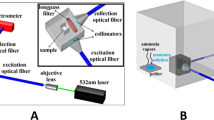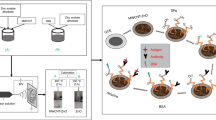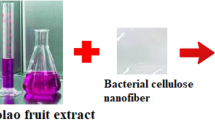Abstract
A fluorescence sensor film for metal ion detection was prepared from a 2,2,6,6-tetramethyl-1-piperidinyloxy radical-oxidized cellulose nanofiber (TOCNF), which was chemically immobilized the metal ion selective ligand, namely, 3,5-bis(((2-hydroxynaphthalen-1-yl)methylene)amino)benzoic acid. The ligand in the TOCNF/ligand films exhibited fluorescence at a 310 nm excitation wavelength and at an ~410 nm emission wavelength. Then, the sensing efficiency and limits were evaluated from the fluorescence of the metal ion-bound ligand. The Stern–Volmer plot of the fluorescence emission intensity of the films increased with increasing of Cu2+ or Cs+ concentration. Accordingly, the sensing of metal ions was more effective on TOCNF with a greater amount of ligand, the sensing of Cu2+ was superior to that of Cs+, and the detection range of the TOCNF/ligand film was wider for Cu2+ than for Cs+. Thus, although the sensitivity of this sensor is lower than the electrochemical detection previously reported, the noticeable potential of the current sensing system is that it is a film type to be easily removable from the sensing water and there is no remaining sensing residue in the water.
This is a preview of subscription content, access via your institution
Access options
Subscribe to this journal
Receive 12 print issues and online access
$259.00 per year
only $21.58 per issue
Buy this article
- Purchase on Springer Link
- Instant access to full article PDF
Prices may be subject to local taxes which are calculated during checkout









Similar content being viewed by others
References
Mon M, Bruno R, Ferrando-Soria J, Armentano D, Pardo E. Metal-organic framework technologies for water remediation: towards a sustainable ecosystem. J Mater Chem A. 2018;6:4912–47.
Howarth AJ, Liu Y, Hupp JT, Farha OK. Metal-organic frameworks for applications in remediation of oxyanion/cation-contaminated water. CrystEngComm. 2015;17:7245–53.
Awual MR, Ismael M, Khaleque MA, Yaita T. Ultra-trace copper(II) detection and removal from wastewater using novel meso-adsorbent. J Ind Eng Chem. 2014;20:2332–40.
Kim MS, Lee SY, Jung JM, Kim C. A new Schiff-base chemosensor for selective detection of Cu2+ and Co2+ and its copper complex for colorimetric sensing of S2− in aqueous solution. Photochem Photobio Sci. 2017;16:1677–89.
Awual MR. New type mesoporous conjugate material for selective optical copper (II) ions monitoring & removal from polluted waters. Chem Eng J. 2017;307:85–94.
ReddyPrasad P, Imae T. Selective detection of copper ion in water by tetradentate ligand sensor. J Taiwan Inst Chem E. 2017;72:194–9.
Awual MR, Hasan MM. Colorimetric detection and removal of copper (II) ions from wastewater samples using tailor-made composite adsorbent. Sens Actuators B Chem. 2015;206:692–700.
Yang H, Luo M, Luo L, Wang H, Hu D, Lin J, et al. Highly selective and rapid uptake of radionuclide cesium based on robust zeolitic chalcogenide via stepwise ion-exchange strategy. Chem Mater. 2016;28:8774–80.
Wang J, Zhuang S. Removal of cesium ions from aqueous solutions using various separation technologies. Rev Environ Sci Biotechnol. 2019;18:231–69.
Ma F, Li Z, Zhao H, Geng Y, Zhou W, Li Q, et al. Potential application of graphene oxide membranes for removal of Cs(I) and Sr(II) from high level-liquid waste. Sep Purif Technol. 2017;188:523–9.
Yoon JY, Zhang H, Kim YK, Harbottle D, Lee JW. A high-strength polyvinyl alcohol hydrogel membrane crosslinked by sulfosuccinic acid for strontium removal via filtration. J Environ Chem Eng. 2019;7:102824.
Kim Y, Eom HH, Kim YK, Harbottle D, Lee JW. Effective removal of cesium from wastewater via adsorptive filtration with potassium copper hexacyanoferrate-immobilized and polyethyleneimine-grafted graphene oxide. Chemosphere. 2020;250:126262.
Liu X, Chen GR, Lee DJ, Kawamoto T, Tanaka H, Chen ML, et al. Adsorption removal of cesium from drinking waters: a mini review on use of biosorbents and other adsorbents. Bioresour Technol. 2014;160:142–9.
Jia F, Wang J. Separation of cesium ions from aqueous solution by vacuum membrane distillation process. Prog Nucl Energ. 2017;98:293–300.
Qian J, Han X, Yang S, Kuang L, Hua D. A strategy for effective cesium adsorption from aqueous solution by polypentacyanoferrate-grafted polypropylene fabric under γ-ray irradiation. J Taiwan Inst Chem Eng. 2018;89:162–8.
Guria UN, Mahapatra AK, Ghosh AK, Bindal RC. Fluorescent chemosensor for lethal cesium detection using thin film membrane. Sep Sci Technol. 2019;54:1687–96.
Arida HAM, Aglan RF, El-Reefy SA. A new cesium ion selective graphite rod electrode based on Cs-Molybdophosphate. Anal Lett. 2004;37:21–33.
Greda K, Jamroz P, Pohl P. The improvement of the analytical performance of direct current atmospheric pressure glow discharge generated in contact with the small-sized liquid cathode after the addition of non-ionic surfactants to electrolyte solutions. Talanta. 2013;108:74–82.
Karadas C, Turhan O, Kara D. Synthesis and application of a new functionalized resin for use in an on-line, solid phase extraction system for the determination of trace elements in waters and reference cereal materials by flame atomic absorption spectrometry. Food Chem. 2013;141:655–61.
Radu A, Peper S, Gonczy C, Runde W, Diamond D. Trace-level determination of Cs+ using membrane-based ion-selective electrodes. Electroanal. 2006;18:1379–88.
Cho ES, Kim J, Tejerina B, Hermans TM, Jiang H, Nakanishi H, et al. Ultrasensitive detection of toxic cations through changes in the tunnelling current across films of striped nanoparticles. Nat Mater. 2012;11:975–85.
Chrastny V, Komarek M. Copper determination using ICP-MS with hexapole collision cell. Chem Pap. 2009;63:512–9.
Tofalvi R, Horvath K, Hajos P. High performance ion chromatography of transition metal chelate complexes and aminopolycarboxylate ligands. J Chromatogr A. 2013;1272:26–32.
Jung JY, Kang M, Chun J, Lee J, Kim J, Kim J, et al. A thiazolothiazole based Cu2+ selective colorimetric and fluorescent sensor via unique radical formation. Chem Commun. 2013;49:176–8.
Radaram B, Mako T, Levine M. Sensitive and selective detection of cesium via fluorescence quenching. Dalton Trans. 2013;42:16276–8.
Zuang J, Zhang L, Lu W, Shen D, Zhu R, Pan D. Determination of trace copper in water samples by anodic stripping voltammetry at gold microelectrode. Int J Electrochem Sci. 2011;6:4690–9.
Shah KJ, Imae T. Selective gas capture ability of gas-adsorbent-incorporated cellulose nanofiber films. Biomacromolecules. 2016;17:1653–61.
Shah KJ, Imae T. Photoinduced enzymatic conversion of CO2 gas to solar fuel on functional cellulose nanofiber films. J Mater Chem A. 2017;5:9691–701.
Ujihara M, Hsu MH, Liou JY, Imae T. Hybridization of cellulose nanofiber with amine-polymers and its ability on sick house syndrome gas decomposition. J Taiwan Inst Chem Eng. 2018;92:106–11.
Ramaraju B, Imae T. Renewable catalyst with Cu nanoparticles embedded into cellulose nano-fiber film. RSC Adv. 2013;3:16279–82.
Ramaraju B, Imae T, Destaye AG. Ag nanoparticle-immobilized cellulose nanofibril films for environmental conservation. Appl Catal A-Gen. 2015;492:184–9.
Prasannan A, Imae T. One-pot synthesis of fluorescent carbon dots from orange waste peels. Ind Eng Chem Res. 2013;52:15673–8.
Kim KB, Kim H, Song EJ, Kim S, Noh I, Kim C. A cap-type Schiff base acting as a fluorescence sensor for zinc (II) and a colorimetric sensor for iron(II), copper(II), and zinc(II) in aqueous media. Dalton Trans. 2013;42:16569–77.
Lee JJ, Choi YW, You GR, Lee SY, Kim C. A phthalazine-based two-in-one chromogenic receptor for detecting Co2+ and Cu2+ in an aqueous environment. Dalton Trans. 2015;44:13305–14.
Isogai A, Saito T, Fukuzumi H. TEMPO-oxidized cellulose nanofibers. Nanoscale. 2011;3:71–85.
Kumar V, Yang T. Analysis of carboxyl content in oxidized celluloses by solid-state 13C CP/MAS NMR spectroscopy. Int J Pharm. 1999;184:219–26.
Kebede MA, Asiku KS, Imae T, Kawakami M, Furukawa H, Wu CM. Stereolithographic and molding fabrications of hydroxyapatite-polymer gels applicable to bone regeneration materials. J Taiwan Inst Chem Eng. 2018;92:91–6.
Isogai A. Development of completely dispersed cellulose nanofibers. Proc Jpn Acad Ser B. 2018;94:161–79.
Kebede MA, Imae T, Sabrina, Wu CM, Cheng KB. Cellulose fibers functionalized by metal nanoparticles stabilized in dendrimer for formaldehyde decomposition and antimicrobial activity. Chem Eng J. 2017;311:340–7.
Kondo T. The assignment of IR absorption bands due to free hydroxyl groups in cellulose. Cellulose. 1997;4:281–92.
Liu CF, Ren JL, Xu F, Liu JJ, Sun JX, Sun RC. Isolation and characterization of cellulose obtained from ultrasonic irradiated sugarcane bagasse. J Agric Food Chem. 2006;54:5742–8.
Zare AJ, Ataeinia P. Synthesis and study of complexes of tetradentate Schiff base and bridging ligand of thiocyanate with transition metals of Fe, Cr and Co. Life Sci J. 2012;9:2396–405.
Awual MR, Ismael M, Yaita T, El-Safty SA, Shiwaku H, Okamoto Y, et al. Trace copper(II) ions detection and removal from water using novel ligand modified composite adsorbent. Chem Eng J. 2013;222:67–76.
Gao Q, Ji L, Wang Q, Yin K, Li J, Chen L. Colorimetric sensor for highly sensitive and selective detection of copper ion. Anal Methods. 2017;9:5094–100.
Awual MR, Hasan MM, Rahman MM, Asiri AM. Novel composite material for selective copper(II) detection and removal from aqueous media. J Mol Liq. 2019;283:772–80.
Yang L, Huang N, Huang L, Liu M, Li H, Zhang Y, et al. An electrochemical sensor for highly sensitive detection of copper ions based on a new molecular probe Pi-A decorated on graphene. Anal Methods. 2017;9:618–24.
Aarjane M, Slassi S, Amine A. Novel highly selective and sensitive fluorescent sensor for copper detection based on N-acylhydrazone acridone derivative. J Mol Struct. 2020;1199:126990.
Qiu S, Wei Y, Tu T, Xiang J, Zhang D, Chen Q, et al. Triazole-stabilized fluorescence sensor for highly selective detection of copper in tea and animal feed. Food Chem. 2020;317:126434.
Acknowledgements
AR gratefully acknowledges the National Taiwan University of Science and Technology, Taiwan, for financial support from the postdoctoral fellowship.
Author information
Authors and Affiliations
Corresponding author
Ethics declarations
Conflict of interest
The authors declare that they have no conflict of interest.
Additional information
Publisher’s note Springer Nature remains neutral with regard to jurisdictional claims in published maps and institutional affiliations.
Supplementary information
Rights and permissions
About this article
Cite this article
Rahmawati, A., Shih, CF. & Imae, T. Film sensor of a ligand-functionalized cellulose nanofiber for the selective detection of copper and cesium ions. Polym J 52, 1235–1243 (2020). https://doi.org/10.1038/s41428-020-0377-y
Received:
Revised:
Accepted:
Published:
Issue Date:
DOI: https://doi.org/10.1038/s41428-020-0377-y



